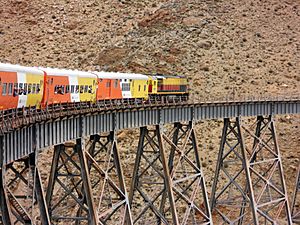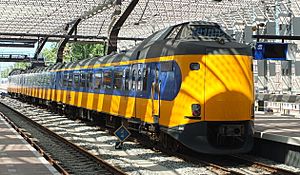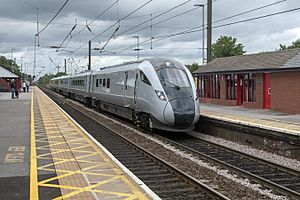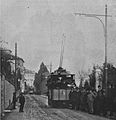Rail transport facts for kids
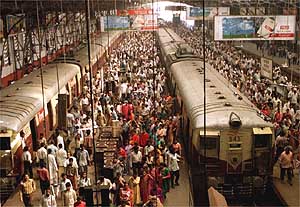
Rail transport is a way of moving people and goods using special vehicles with wheels. These vehicles run on railway tracks. In many countries, trains help with trade and make the economy grow. Railways are a very good way to move things across land because they use energy wisely.
Train tracks are usually made of steel rails. These rails sit on ties (also called sleepers) which are placed in ballast (crushed stone). The train's wheels, usually made of metal, roll smoothly on these rails. Sometimes, rails are fixed directly onto a concrete base.
Trains have less resistance than cars or trucks with rubber tires. This means many passenger cars or freight wagons can be linked together to form long trains. A railway company runs the trains. They move people between train stations or goods to customer places.
Trains get their power from locomotives. Some locomotives use electric power from overhead lines or a third rail. Others use diesel engines to make their own power. Most tracks have a signalling system to keep trains safe. Railways are a very safe way to travel on land. They can carry many people and a lot of cargo. They also use energy well.
Contents
A Look Back: History of Railways
Rail transport became very important during the Industrial Revolution.
Early Beginnings
The first known railways were used in ancient Corinth, Greece, around 600 BC. People or animals pulled carts on these tracks. In the mid-1500s, horse-powered funiculars and wagonways started in Germany. These were early forms of rail transport.
The Steam Engine Revolution
Modern rail transport began in the early 1800s in Britain. This was when steam locomotives were invented. The railway system in Great Britain is the oldest in the world.
George Stephenson and his son Robert built the Locomotion No. 1. This was the first steam locomotive to carry passengers on a public railway line. It ran on the Stockton and Darlington Railway in 1825. George Stephenson also built the first public railway that only used steam locomotives. This was the Liverpool and Manchester Railway, which opened in 1830.
Railways Change the World
Steam engines allowed for main railway lines to be built. These lines were a key part of the Industrial Revolution. Railways made shipping goods cheaper. Fewer goods were lost compared to water transport, where ships could sink.
The shift from canals to railways helped create "national markets." This meant prices for goods were similar from city to city. The spread of railways also led to standard time in Britain. Before railways, each town had its own local time. The invention of railways was one of the most important changes of the 1800s. The world's first underground railway, the Metropolitan Railway in London, opened in 1863.
Modern Trains: Electric and High-Speed
Electric and Diesel Trains
In the 1880s, electric trains were introduced. This led to electric tramways and city transit systems. From the 1940s, most non-electric railways replaced steam locomotives. They started using diesel-electric locomotives instead. By the 2000s, this change was almost complete.
Super Fast Trains
In the 1960s, high-speed railway systems began in Japan. Later, other countries also built them. Many countries are now changing from diesel to electric locomotives. This is mainly because electric trains are better for the environment. For example, Switzerland has almost completely electrified its railway network. Other types of guided transport, like monorails or maglev trains, have been tried. However, they are not as widely used as traditional railways.
Why Railways Are Important Today
After World War II, fewer people used trains because cars and airplanes became popular. But in recent years, rail transport has become important again. This is because roads are often crowded, and fuel prices are rising. Governments are also investing in railways. They see trains as a way to reduce carbon dioxide emissions. This helps with concerns about global warming.
Related pages
Images for kids
-
A train passing a station in Taiwan.
-
A steam-powered excursion train in Japan.
-
An early electric tram in Lugano, Switzerland, 1896.
-
The 0-Series Shinkansen from Japan, introduced in 1964.
-
A high-speed train at a station in Tampere, Finland.
-
A long freight train crossing a bridge in British Columbia.
-
A railway signal box in England from 1899.
-
A goods station in Lucerne, Switzerland.
-
A train owned by the Union Pacific Railroad in the United States.
-
A German Intercity Express (ICE) train.
See also
 In Spanish: Ferrocarril para niños
In Spanish: Ferrocarril para niños


